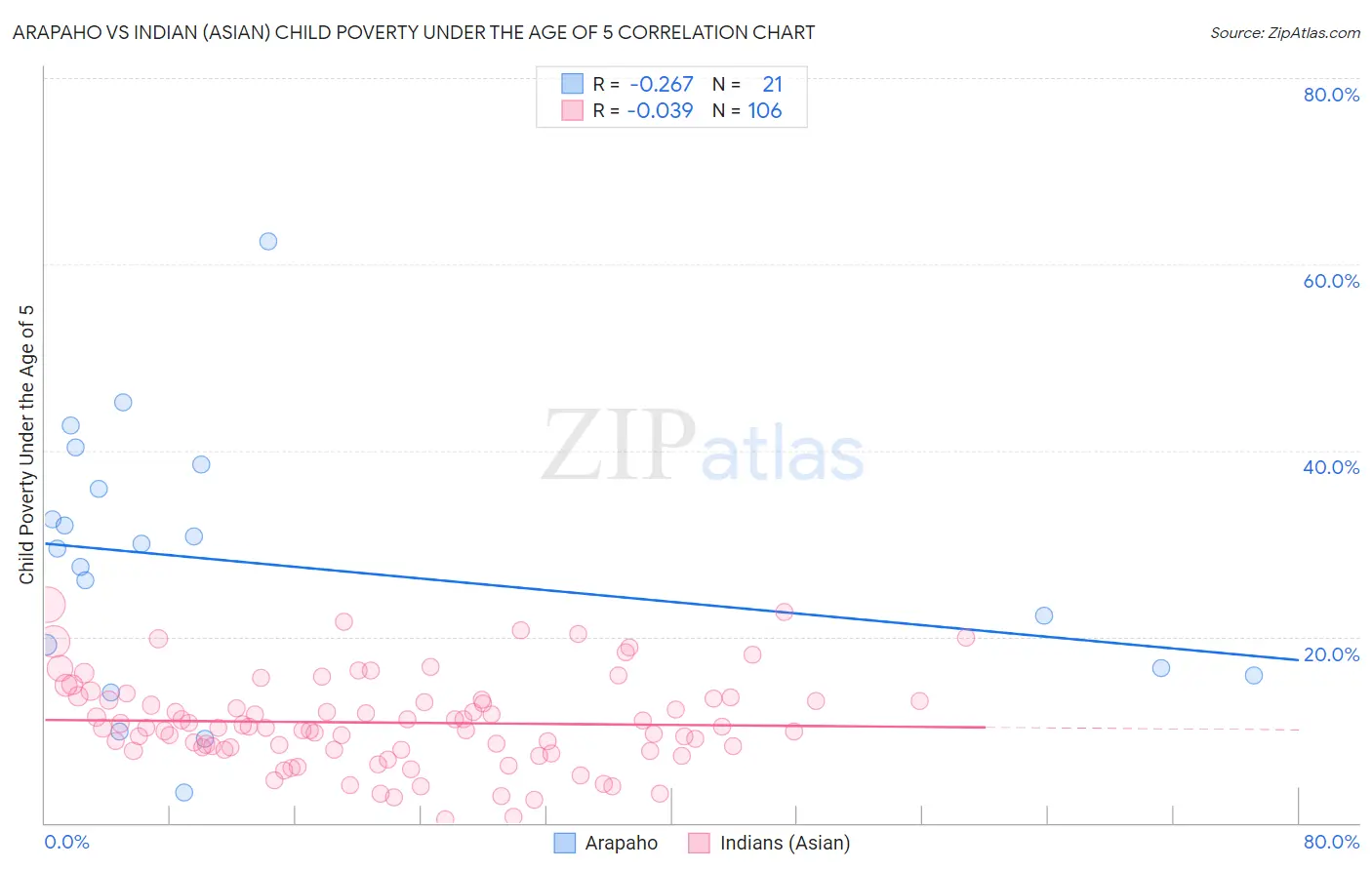Arapaho vs Indian (Asian) Child Poverty Under the Age of 5
COMPARE
Arapaho
Indian (Asian)
Child Poverty Under the Age of 5
Child Poverty Under the Age of 5 Comparison
Arapaho
Indians (Asian)
23.1%
CHILD POVERTY UNDER THE AGE OF 5
0.0/ 100
METRIC RATING
315th/ 347
METRIC RANK
13.4%
CHILD POVERTY UNDER THE AGE OF 5
100.0/ 100
METRIC RATING
15th/ 347
METRIC RANK
Arapaho vs Indian (Asian) Child Poverty Under the Age of 5 Correlation Chart
The statistical analysis conducted on geographies consisting of 29,632,672 people shows a weak negative correlation between the proportion of Arapaho and poverty level among children under the age of 5 in the United States with a correlation coefficient (R) of -0.267 and weighted average of 23.1%. Similarly, the statistical analysis conducted on geographies consisting of 467,922,694 people shows no correlation between the proportion of Indians (Asian) and poverty level among children under the age of 5 in the United States with a correlation coefficient (R) of -0.039 and weighted average of 13.4%, a difference of 71.9%.

Child Poverty Under the Age of 5 Correlation Summary
| Measurement | Arapaho | Indian (Asian) |
| Minimum | 3.3% | 0.39% |
| Maximum | 62.5% | 23.5% |
| Range | 59.2% | 23.1% |
| Mean | 27.8% | 10.8% |
| Median | 29.5% | 10.3% |
| Interquartile 25% (IQ1) | 16.3% | 7.8% |
| Interquartile 75% (IQ3) | 37.2% | 13.2% |
| Interquartile Range (IQR) | 20.9% | 5.3% |
| Standard Deviation (Sample) | 14.1% | 4.8% |
| Standard Deviation (Population) | 13.7% | 4.8% |
Similar Demographics by Child Poverty Under the Age of 5
Demographics Similar to Arapaho by Child Poverty Under the Age of 5
In terms of child poverty under the age of 5, the demographic groups most similar to Arapaho are Yakama (23.1%, a difference of 0.12%), U.S. Virgin Islander (23.0%, a difference of 0.56%), Menominee (23.3%, a difference of 0.62%), Bahamian (23.0%, a difference of 0.65%), and Honduran (23.0%, a difference of 0.70%).
| Demographics | Rating | Rank | Child Poverty Under the Age of 5 |
| Immigrants | Dominica | 0.0 /100 | #308 | Tragic 22.7% |
| Houma | 0.0 /100 | #309 | Tragic 22.7% |
| Africans | 0.0 /100 | #310 | Tragic 22.8% |
| Seminole | 0.0 /100 | #311 | Tragic 22.8% |
| Hondurans | 0.0 /100 | #312 | Tragic 23.0% |
| Bahamians | 0.0 /100 | #313 | Tragic 23.0% |
| U.S. Virgin Islanders | 0.0 /100 | #314 | Tragic 23.0% |
| Arapaho | 0.0 /100 | #315 | Tragic 23.1% |
| Yakama | 0.0 /100 | #316 | Tragic 23.1% |
| Menominee | 0.0 /100 | #317 | Tragic 23.3% |
| Dutch West Indians | 0.0 /100 | #318 | Tragic 23.3% |
| Chippewa | 0.0 /100 | #319 | Tragic 23.4% |
| Choctaw | 0.0 /100 | #320 | Tragic 23.5% |
| Immigrants | Honduras | 0.0 /100 | #321 | Tragic 23.5% |
| Ute | 0.0 /100 | #322 | Tragic 23.5% |
Demographics Similar to Indians (Asian) by Child Poverty Under the Age of 5
In terms of child poverty under the age of 5, the demographic groups most similar to Indians (Asian) are Okinawan (13.4%, a difference of 0.050%), Immigrants from Eastern Asia (13.5%, a difference of 0.51%), Bhutanese (13.4%, a difference of 0.70%), Assyrian/Chaldean/Syriac (13.6%, a difference of 0.86%), and Immigrants from China (13.6%, a difference of 1.1%).
| Demographics | Rating | Rank | Child Poverty Under the Age of 5 |
| Iranians | 100.0 /100 | #8 | Exceptional 13.1% |
| Immigrants | Iran | 100.0 /100 | #9 | Exceptional 13.1% |
| Burmese | 100.0 /100 | #10 | Exceptional 13.2% |
| Immigrants | Korea | 100.0 /100 | #11 | Exceptional 13.2% |
| Immigrants | South Central Asia | 100.0 /100 | #12 | Exceptional 13.3% |
| Bhutanese | 100.0 /100 | #13 | Exceptional 13.4% |
| Okinawans | 100.0 /100 | #14 | Exceptional 13.4% |
| Indians (Asian) | 100.0 /100 | #15 | Exceptional 13.4% |
| Immigrants | Eastern Asia | 100.0 /100 | #16 | Exceptional 13.5% |
| Assyrians/Chaldeans/Syriacs | 100.0 /100 | #17 | Exceptional 13.6% |
| Immigrants | China | 100.0 /100 | #18 | Exceptional 13.6% |
| Immigrants | Ireland | 100.0 /100 | #19 | Exceptional 13.7% |
| Immigrants | Japan | 100.0 /100 | #20 | Exceptional 13.8% |
| Bolivians | 100.0 /100 | #21 | Exceptional 13.8% |
| Immigrants | Bolivia | 100.0 /100 | #22 | Exceptional 13.8% |